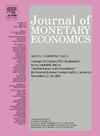再论作为总供给冲击的相对价格变化:理论与证据
IF 4.3
2区 经济学
Q1 BUSINESS, FINANCE
引用次数: 0
摘要
我们提供的理论和证据表明,相对价格冲击会导致总通胀,并起到总供给冲击的作用。经验表明,外生的正能源价格冲击不仅会对总体通胀率产生积极影响,还会对美国的核心通胀率产生积极影响,同时会抑制美国的实际活动。在一个具有上下游部门和异质价格粘性的双部门货币模型中,我们分析了上游冲击如何传播到价格中。利用面板 IV 本地预测,我们表明部门 PCE 价格对能源价格冲击的反应与模型预测一致。在美国后 COVID 通胀的激励下,模型实验表明,一次性的相对价格冲击会产生与数据中观察到的类似的总体和核心通胀的持续变动,即使在没有总量松弛的情况下也是如此。该模型还强调,货币政策立场在此类冲击的传播中发挥着重要作用。本文章由计算机程序翻译,如有差异,请以英文原文为准。
Relative-price changes as aggregate supply shocks revisited: Theory and evidence
We provide theory and evidence that relative price shocks can cause aggregate inflation and act as aggregate supply shocks. Empirically, we show that exogenous positive energy price shocks have a positive impact not only on headline but also on U.S. core inflation while depressing U.S. real activity. In a two-sector monetary model with upstream and downstream sectors and heterogeneous price stickiness, we analytically characterize how upstream shocks propagate to prices. Using panel IV local projections, we show that the responsiveness of sectoral PCE prices to energy price shocks is in line with model predictions. Motivated by post-COVID inflation in the U.S., a model experiment shows that a one-time relative price shock generates persistent movements in headline and core inflation similar to those observed in the data, even in the absence of aggregate slack. The model also emphasizes that monetary policy stance plays an important role in propagation of such shocks.
求助全文
通过发布文献求助,成功后即可免费获取论文全文。
去求助
来源期刊

Journal of Monetary Economics
Multiple-
CiteScore
7.20
自引率
4.90%
发文量
90
审稿时长
74 days
期刊介绍:
The profession has witnessed over the past twenty years a remarkable expansion of research activities bearing on problems in the broader field of monetary economics. The strong interest in monetary analysis has been increasingly matched in recent years by the growing attention to the working and structure of financial institutions. The role of various institutional arrangements, the consequences of specific changes in banking structure and the welfare aspects of structural policies have attracted an increasing interest in the profession. There has also been a growing attention to the operation of credit markets and to various aspects in the behavior of rates of return on assets. The Journal of Monetary Economics provides a specialized forum for the publication of this research.
 求助内容:
求助内容: 应助结果提醒方式:
应助结果提醒方式:


